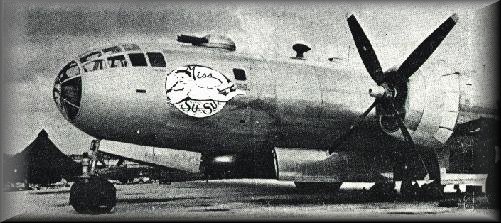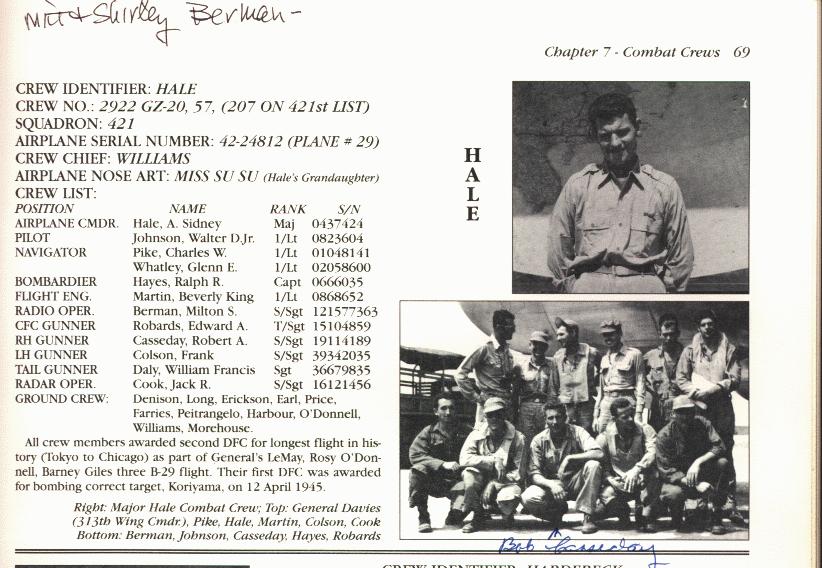
This is the plane that S/Sgt.Robert Casseday was the Right Blister gunner in during WW2. He had a total of 483.2 combat hours of flight time. These were all done while he was stationed on Tinian from Dec, 44 until Oct 45.




This anecodote documents an incident which protrays a very tragic happening in the 504th's WW2 experience. If I were to say that this mission or that mission was the worst, it would be hard to decide which fit the description.
I know that when we got into the fire-storm over Osaka, the thermals were so bad from the horrendous incendiary fires burning below that our airplane was turned upside down. It was a very terrifying experience! The plane's structure was stressed so badly that I didn't think it ever flew again after we returned to Tinian. I know we were given another B-29. Major Hale's crew was designated as a lead crew with a special stripe painted around the airplanes's tail.
The mission to Yokahama that I relate herein was without a doubt one of our worst experiences. It can also be called our luckiest day!! Here' the way it happened.
It was a day-mission to Yokohama. Major Sid Hale and Major Langdale were the formation leaders. I was right blister gunner on Hales's crew. It took only this one mission to eliminate Yokohama as a target. Our group received the Presidential Unit Citation for this mission.
Captain Worde's and Captain Cornwell's planes were shot down on this terrible mision. Colonel Connally, our first 504th Bomb Group commander was flying as a observer on the Cornwell's airplane. All were lost in Captain Cornwell's plane that day. Captain Worde's crew bailed out and spent the rest of the war as POW's. Fortunately all eleven of his crewmembers survived the war.
This is the way the mission went for Major Hale's crew. Major Langdale was the formation leader of the squadron ahead of us . By the time we reached the initial point where we lined up for the bomb run, the flak was so intense that it formed a black cloud-Japanese fighter planes were staying outside of the flak area waiting to jump on the cripples.
Our first major problem was a flak hit in our left wing that opened up a large hole in our wing tank.We looked like a crop-duster airplane with our fuel coming our of the wing as a vapor. We didn't dare fire our guns at this point as it could have caused our plane to blow up. I was wondering why the exhaust from the engines didn't ignite the fuel as it was streaming out of the wing.
The other planes in our formation saw our plight and quickly maneuvered away from us. The damage was reported to King Martin, our flight engineer, and he immediately began transferring fuel to other tanks.
Major Hale radioed the other pilots in our formation and said "we have work to do. Please get back on my wing". They did!
The fuel tank self-sealing feature soon slowed the fuel leaks and then stopped them altogether. We were still taking a terrific pounding from the enemy flak, and the Japanese fighters were circling outside the flak area waiting to jump us.
We were now on our bomb run when Captain Worde's plane took a direct flak hit in the No. 1 engine and blew the engine right off the airplane. Captain Worde was flying on our right wing position. I could see that there was no engine in his No. 1 nacelle position attaached to the firewall. Being right gunner, I could see all of his engine's attachment lines torn loose. The gas-line was on fire and draped back across the top of the wing.
At this point, Captain Worde's plane, which was a little higher than ours began a slow turn into us. His plane began banking steeply (10, 15, 20, 25 degrees). I shouted over intercom, "Pull up-pull up" I guess Lt. Johnson, our pilot looked back and what he saw made him pull back sharply on our plane's controls which allowed Worde's plane to go under us. It was about this time that we released our bombs some of them struck Worde's plane as it passed beneath us.
Worde's plane continued in a steep bank, Its wing did not miss us by more than 3 or 4 feet. I didn't see anyone bail out of his plane and didn't know until the first 504th Bomb Group Reunion in Omaha after the war that the entire crew survived.
After we flew out of the flak area, Japanese fighters attempted firing passes at our formatin. Every time they started a pass at us , our guardian angel drove them off since we couldn't shoot our guns in defense. This angel was a P-51 fighter. He would stay above the Japanese fighters and when they started to attack, he would drive them off. He was our friend and protector!
After we left the Japanese mainland, the P-51 joined up with us. He came along on our right side and slid his canopy back. He flew first under our wing tip then slide under our plane to the other side's wing tip, then he came back under us and positioned his plane where he could see me. He looked at me in the blister and just shook his head. I still remember the name painted on the side of his P-51. It was MARY JANE II. The P-51 escorted us back all the way to Iwo Jima, his base.
We had oil leaking out of numbers 3 and 4 engines. It was running over the top of our wing and dripping off the trailing edge. Lieutenant King Martin, our engineer, would alternate running these two engines to conserve oil. We did not stop at Iwo Jima but flew on and landed on Tinian with all engines running on the oil we had left in these engines. There couldn't have been much oil left.
When we were on final approach, the gear and flaps were let-down for landing. The right flap had such a large hole in it-about 4 or 5 feet long and 2 to 3 feet wide-that it affected our flight control. The flaps had to be retracted to 20 to 30 degrees instead of full extension which made the plane more stable, but increased our landing speed above normal. It was a good thing that Tinian's North Field runways were 8,500 feet long because when our brakes were applied, we found that had several brake line hydraulic leaks-thus had no brakes.
The engineer shut-down all engines after we touched down, and we coasted down the runway. We were still going about 10 to 15 miles per hour as we approached the end of the runway
Robards, our CFC gunner, and myself jumped out of the back of the airplane and ran along beside the airplane and at the side of the runway and picked up coral rocks the size of basket balls. We threw the rocks under the nose-wheel to help slow the airplane down. The wheel just jumped over the rocks, Finally the third rock that Robards threw, caught the wheel and caused it to skid and slow the plane down just before the plane rolled off the end of the runway and down the embankment. A cletrack tow vehicle then pulled our airplane off the runway and over to a nearby hardstand.
We counted well over a hunderd holes in the airplane! One of the main gear tires had a big hole in it from flak and of course was flat. The radio operators's seat was torn apart by the flak. This occurred when Berman was watching the action from the astrodome during the bomb run.
There was a hole in the left blister as big as your fist that was also caused by the flak. That was Frank Colson's position. Flak also hit the CFC hunners chair. One Blade in the porpeller on either three or four engine had the tip bent back like a pretzel. Futher examination of the plane revealed that our horizontal stabilizers had large dents in their leading edges. Each dent was about 4 feet long and a foot deep. These dents were caused when a large diamenter Japanese projectile went into the left wing and then travelled along the main spar through the gas tanks and on into the fuselage and finally hitting the life raft compartment. The dinghies are spring loaded in assure ejection and when the projectile hit in this area, both dinghies were ejected and hit our horizontal stablizers while still tightly folded, thus causing the dents.
The miracle that saved us was that the projectile was a "dud" and didn't explode! It was removed using a "cherry picker" and placed in a steel container and taken to a remote area and exploded. Our skilled maintenance crews reparied this badly damaged airplane into like-new B-29. After the airplane was repaired, it was given to a replacement crew and they renamed the plane FLYING PATCHES, a very apt name.
That was the way it was on our 20th mission on 24 May, 1945! Our crew was very lucky to survive that awesome mission which was important enought to earn our unit the Presidential Citation.

| Home |
Wife |
Nose Art |
Demise of Miss SuSu |
Casseday | Ground Crew |
Taps |
Stories |
Jack Cook |
POW |